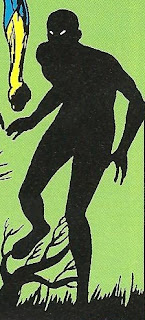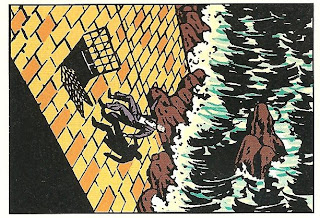When I read The Golden Age Spectre Archives a few months ago, I was surprised that one of the things it was lacking in was the kind of gruesome, creative punishments that The Spectre would become (in) famous for. Oh, he kills the villains now and then, sometimes in ways that are pretty cringe-worthy even today, but these really come off more as isolated instances. Even more distressing, most of the deaths really aren’t creative at all, he mostly just stares at the villains and they drop dead. It always feels quick and impersonal, without the sadism prevalent in later incarnations of the character. In fact, some of my favorite “punishments” in the original 40’s series aren’t even actual deaths at all. Batman (in the pre-Robin stories), Hawkman and Doctor Fate all trump Spec in terms of not letting the villains survive, and none of them during that period had anything on a guy named The Hangman over at Archie Comics (how ironic).
Still, I thought it would be fun to list the creepiest punishments that Spectre has ever meted out. You’ll never mock a half-naked man in pixie boots again.
13) Jim Corrigan ages Gat Benson’s henchman to death:
Right from the two-parter that introduced him, The Spectre made it clear how brutal he could be, here he ages a guy so much that before long he is literally a walking, talking (and sweating) skeleton before just dropping dead. Weirdly enough, Spectre lets Benson himself live. 12) You’ll never toss comets around in this galaxy again!
The Spectre’s comet-tossing archenemy Zor returns and kidnaps Clarice Winston. Being thoroughly beat at this point, our hero calls on God for help, who suggests he use, well:
Spectre goes to a country called Lugania (which has Ectobane trees) and breaks the wood down into a coffin.
Ladies and gentlemen, this just proves you don’t need to kill to provide a bizarre punishment.
One wonders what the Lugania forest committee would think of Spectre cutting down their trees, but in a land with trees that ward off all evil, I imagine they don’t have hippies there. If Lugania was real, I think that’s where I’d retire.
11) Giant Spectre crushes a car with his bare hands:
Probably the most often-cited scene in the original run, I didn’t even have to scan my Archive, I just googled for it and up it came. Damn that’s brutal.
10) Spectre is a gigantic hypocrite:
In this story, a state’s witness named Elmer Watson is brutally murdered by some mobsters.
Note the "Dead End" sign. Some nice black humor by Baily.
However, Watson’s shadow still lives and (occasionally materializing as a green-skinned, stereotypical looking hooded ghost) hunts down the mobsters.
The Spectre sets out to stop Watson’s vendetta. I mean, killing criminals? Spec would never do that! Oh wait… I should point out that Watson specifically states that he is unable to rest in peace because his soul is trapped on earth, and tells this to Spec.
While pursuing the head gangster, who is fleeing on a train, Watson grows to giant size, and, clearly out of ignorance and not out of genuine malice, poses a threat to the train as a whole (clearly, Jerry Siegel must have realized that at this point, Watson wasn’t doing anything Spectre himself wouldn’t, so he made this up to make us lose empathy for Watson).


So, rather than simply elevating the train out of harm’s way or showing Watson that he has become as bad as his murderers, what does our hero do? He uses the Ring of Life which God gave him (a deus ex machine that would get Spectre out of anything in these stories) to completely obliterate Watson out of existence. Never at any time does the Spectre attempt to truly reason with Watson, or to guide him up to heaven and reassure him that his killers would pay, he just spouts off a bunch of crap about how revenge is pointless and that the courts and the almighty are the only ones who should be allowed to decide the fate of criminals (HAHAHAHAHA).
Jim Corrigan would later be retconned into being a religious fanatic, and this supports it, as he clearly believes in the maxim that “Vengeance is mine, sayeth the lord”, although here it comes off more like “Hey buddy, this whole vengeful-ghost-who-slaughters-murderers-without-a-fair-trial business is MY racket.”
9) The Spectre turns oil paint monsters into oil:
In one of the best stories of the original run, a group of (oddly cute) monsters begin rampaging throughout the city. Spec tracks them down to a “prehistoric” oil painting from the city museum, which is a portal to another dimension ruled by a hunchbacked maniac. The monsters’ goal is to destroy the human world because the human who painted them made them ugly, or something, it’s never quite clear. One doesn’t read Golden Age Spectre stories for the writing, but for Jerry Siegel’s surreal ‘anything-goes” plots and Bernard Baily’s delightfully awkward artwork, although the art is not without its occasional truly stunning moments.
This is one such moment: The monsters attack our hero, who promptly turns them into what they originally were; globs of oil.
Surrealism rarely gets better than this in mainstream superhero comics.
8) Spectre melts a guy to death:
When Jim Aparo and Michael Fleischer were handed The Spectre in Adventure Comics, boy did they let loose, this one comes from their very first story. Ick.
7) Spectre cuts a guy up with a giant pair of scissors:
This is probably the most well-remembered moment in the Aparo run. I think the reason why is because this doesn’t have the distinction of being something relatively silly like Spectre turning a guy into an inanimate object like glass or sand or goo and dying a relatively painless death, but is plainly and simply a guy being straight up murdered in a truly gruesome manner. This is less the territory of fantasy, or even traditional EC comic book horror, but of slasher films before they were even a genre. It hurts just looking at it.
6) Spectre turns a guy into a mannikin and lets him get roasted alive:
While the previous entry may be the most well-remembered moment from this run, this is probably the best remembered story, and it’s my personal favorite Spectre story of all time. This one actually has a plot other than “Spectre kills crooks and pines for Gwendolyn Sterling” (My my Spectre, combine the first name of your original love interest Clarice Winston with the last name of your current one, and you have yourself the protagonist for a certain series of novels and films…). Even this guy seems to like it. The plot is especially creepy because so much goes unexplained; department store mannikins start inexplicably coming to life and killing people, and not much is ever answered as to why. There are a lot of twists and turns, but the ending is what sticks out: The fiendish mannikin maker is turned into one himself (fully conscious but frozen), and then gets thrown in a heap with his own dummies and roasted alive while two janitors make small talk.
It’s droll, ironic, and absolutely horrifying. It gave young me a long-lasting childhood fear of dummies and mannikins, and even more so of becoming one, that Twilight Zone episode with Cliff Robertson didn’t help.
4) Spectre feeds a guy to a giant squid:
Even Spectre has a weakness for HP Lovecraft and random bullshit.
3) Spectre feeds a guy to a giant rubber ducky:
In this story, a two-parter that was the conclusion of the Aparo run, God grants Jim Corrigan’s request that he become human again and can give up being The Spectre. Jim and Gwendolyne decide to get married, and this turns largely into a 70s updating of More Fun #52-53.
Jim runs afoul of a mob boss named “Ducky”. He has a rubber duck. Yeah….
Jim gets gunned down, buried, comes back as The Spectre again, and causes the duck to come alive, grow to giant size, and swallow the mobster whole. Somewhere, Bert is ruing the day he let Ernie read this comic, as his roommate hasn’t taken a bath in ages because of it.
2) Spectre turns heroin junkies into his fingertips and then injects them with liquid fire:
The 1990’s Spectre series, for all of Ostrander’s desire to deconstruct the Spectre mythos, nevertheless came up with “punishment” scenarios that put even Fleischer and Aparo to shame. This one from the first issue is gold. Every junkie is like the setting sun indeed. 1) Spectre burns down an entire fucking country:
HOLY FUCKBALLS JUST READ THIS
So there you have it. That said, I think I’ll quit these character-centric lists for now, especially about undead supernatural beings in the DC Universe with chalk-white skin and lousy fashion sense. Think I’ll go make myself some cocoa and watch some W.C. Fields movies.
Say, did I leave the window open? I just felt a cold breeze--OHFUCK!KGKGLL;FD;SLKU7471111111111111111111111111



























































